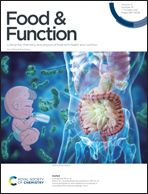Potential prebiotic properties of exopolysaccharides produced by a novel Lactobacillus strain, Lactobacillus pentosus YY-112
Abstract
Exopolysaccharides (EPSs) derived from Lactobacilli have important physiological effects and are commonly used as new prebiotics. We identified and studied a new Lactobacillus strain, YY-112, isolated from waxberry (Myrica rubra). This strain, identified as Lactobacillus pentosus, tolerates acids, bile salts, and artificial digestive fluids. The EPS derived from this strain weighed 5.9 × 104 Da and contained glucose, mannose, glucosamine, galactose, and rhamnose at 62.69 : 85.85 : 2.46 : 2.92 : 1.00 molar ratios. We found that the EPS from this strain increased the ratio of Bacteroidetes to Firmicutes and decreased the relative abundance of Proteobacteria, especially Escherichia–Shigella, when added to a simulated gastrointestinal system in vitro. After analysing the short-chain fatty acids, we found that this EPS promoted the production of acetic acid, propionic acid, and butyric acid, and reduced the ratio of acetic acid to propionic acid. We conclude that Lactobacillus pentosus YY-112 is a potential probiotic strain with EPS that is beneficial for the intestinal microbiota and short-chain fatty acid production.



 Please wait while we load your content...
Please wait while we load your content...